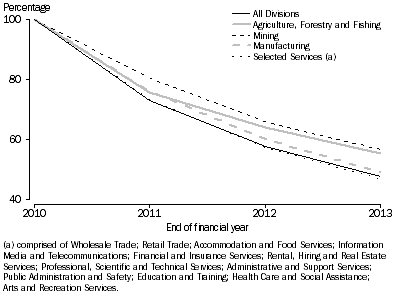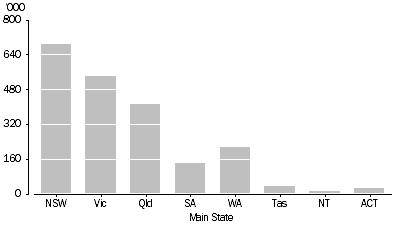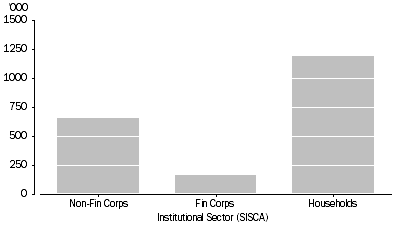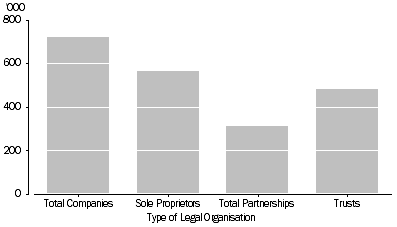|
|
SUMMARY OF FINDINGS
- There were 2,079,666 actively trading businesses in Australia at June 2013. This was a decrease of 61,614 (-2.9%) businesses from 2012.
- For the 2012-13 financial year, the entry rate (11.2%) of businesses was lower than the exit rate (14.1%) resulting in a decrease in the number of overall businesses.
- The entry rate of businesses decreased by 2.3 percentage points (-48,292) from 13.5% to 11.2% for the 2012-13 financial year. This was after a decrease of 0.4 percentage points (-6,689) in the 2011-12 financial year.
- The exit rate of businesses increased by 1.0 percentage point (22,190) from 13.1% to 14.1% for the 2012-13 financial year. This was after a decrease of 0.4 percentage points (-7,795) for the 2011-12 financial year.
- In terms of business survival rates, of the 2,050,642 businesses operating in June 2009, 86.9% were still operating in June 2010, 77.4% were still operating in June 2011, 69.9% were still operating in June 2012 and 62.9% were still operating in June 2013.
- Of the 342,753 new business entries during 2009-10, 73.1% were still operating in June 2011, 57.7% were still operating in June 2012 and 47.5% were still operating in June 2013.
INDUSTRY
- At June 2013, the 'Construction' industry had the highest number of business operating in Australia (328,486). This was followed by the 'Professional, Scientific and Technical Services' (241,814) and 'Rental, Hiring and Real Estate Services' (219,878) industries.
- At June 2013, the 'Electricity, Gas, Water and Waste Services' industry had the lowest number of business operating in Australia (5,606). This was followed by the 'Public Administration and Safety' (7,274) and 'Mining' (8,094) industries.
- During the 2012-13 financial year, the 'Accommodation and Food Services' and 'Public Administration and Safety' industries had the highest entry rates of 13.6% and 12.4% respectively.
- 'Agriculture, Forestry and Fishing' and 'Rental, Hiring and Real Estate Services' industries had the lowest entry rates of 4.9% and 6.2% respectively in 2012-13.
- During the 2012-13 financial year, the 'Administrative and Support Services' and 'Public Administration and Safety' industries had the highest exit rates of 18.6% and 18.2% respectively.
- 'Health Care and Social Assistance' and 'Agriculture, Forestry and Fishing' industries had the lowest exit rates of 8.6% and 8.9% respectively, in the 2012-13 financial year.
- The survival rates at June 2013 for businesses operating in June 2009 were highest for 'Health Care and Social Assistance' (75.1%) and 'Rental, Hiring and Real Estate Services' (71.6%), followed by 'Agriculture, Forestry and Fishing' (71.3%).
- The survival rates at June 2013 for businesses operating in June 2009 were lowest for 'Public Administration and Safety' (53.1%), 'Accommodation and Food Services' (54.5%), followed by 'Administrative and Support Services' (55.0%).
Survival of Entries by ANZSIC Industry Division, as a % of business entries during financial year 2009-10

MAIN STATE OF OPERATION
- The state with the highest number of businesses operating in 2012-13 financial year was New South Wales (688,774). This was followed by Victoria (538,775), Queensland (414,438), Western Australia (215,972), South Australia (143,301), Tasmania (37.484), the Australian Capital Territory (25,245) and the Northern Territory (14,313).
- For the 2012-13 financial year, each state recorded a decrease in the number of businesses.
- The largest decrease in businesses for a single state was in New South Wales (-21,918). This was followed by Queensland (-14,270).
- The highest entry rate for a single state was in the Northern Territory (12.8%). This was followed by the Australian Capital Territory (12.3%).
- The highest exit rate for a single state was in the Australian Capital Territory (15.3%). This was followed by the Northern Territory (15.1%).
- Of the businesses operating in June 2009, the highest survival rates in June 2013 were seen in Tasmania (66.6%) and South Australia (65.8%). The lowest survival rate was seen in the Australian Capital Territory (60.3%).
Business count by main state, operating at end of financial year 2012-13

INSTITUTIONAL SECTOR
- Of the 2,079,666 businesses operating in 2013, the largest contributor was 'Households', 56.9% (1,183,305) which includes most unincorporated businesses, followed by 'Non-Financial Corporations' (649,449) and 'Financial Corporations' (163,236).
- The 'Households', 'Non-Financial Corporations' sector and 'Financial Corporations' sectors contracted by 6.2%, 2.7% and 0.1% respectively in 2012-13 financial year.
- The 'Financial Corporations' sector had the largest entry rate at 10.8%. This was followed by 'Non-Financial Corporations' (9.7%) and 'Households' (8.4%).
- The 'Households' sector exhibited the largest exit rate of 14.6%. This was followed by 'Non-Financial Corporations' (12.4%) and 'Financial Corporations' (10.9%).
- The survival rates at June 2013 for businesses operating in June 2009 were highest for 'Non-Financial Corporations' (67.3%), followed by 'Financial Corporations' (66.8%) and 'Households' (61.0%).
- Of the businesses that entered during 2009-10, the highest survival rate in June 2013 was seen in the 'Financial Corporations' sector (58.9%), followed by 'Non-Financial Corporations' (53.6%) and 'Households' (46.4%).
Business counts by Institutional Sector, operating at the end of financial year 2012-13

TYPE OF LEGAL ORGANISATION
- At June 2013, there were 722,198 'Companies' in Australia, followed by 564,869 'Sole Proprietors', 481,730 'Trusts' and 310,296 'Partnerships'. There were a relatively small number of businesses operating in the 'Public Sector' (573).
- 'Public Sector' includes Public Trading Enterprises only. Therefore, it excludes General Government, Police Services and Fire Protection and Other Emergency Services.
- During the 2012-13 financial year, the entry rate was highest for 'Sole Proprietors' (12.9%), followed by 'Companies' (12.2%), 'Trusts' (10.6%), the 'Public Sector' (8.2%) and 'Partnerships' (6.6%).
- During the 2012-13 financial year, the exit rate was highest for 'Sole Proprietors' (19.9%), followed by 'Companies' (12.8%), the 'Public Sector' (12.5%), 'Partnerships' (11.8%) and 'Trusts' (10.1%).
- The survival rates at June 2013 for businesses operating in June 2009 were highest for 'Trusts' (70.8%), followed by 'Companies' (66.6%), 'Partnerships' (64.4%), the 'Public Sector' (62.8%) and 'Sole Proprietors' (52.4%).
Business counts by Type of Legal Organisation, operating at the end of financial year 2012-13 (Private Sector)

EMPLOYMENT SIZE RANGES
- At June 2013, there were 815,368 'Employing' businesses and 1,264,298 'Non-employing' businesses.
- There were 563,412 businesses that employed '1-4' employees, followed by 197,412 businesses that employed '5-19' employees, 50,946 businesses employing '20-199' employees and 3,598 businesses that employed '200+' employees.
- For the 2012-13 financial year, the highest amount of entries were seen in the 'Non-employing' employment business range (12.4%). This was followed by the '1-4' employment size range (11.7%), the '5-19' employment size range (4.3%), the '20-199' employment size range (2.6%) and the '200+' employment size range (2.3%).
- The highest exit rate was in the 'Non-employing' businesses (17.4%) followed by the '1-4' employment size range (10.2%), the '5-19' employment size range (5.9%), the '200+' employment size range (4.4%) and the '20-199' employment size range (3.9%).
Entries and Exits by Employment Size Range, as a % of business counts at the start of financial year 2012-13

ANNUAL TURNOVER SIZE RANGES
- At June 2013, there were 556,504 businesses operating in the 'Zero to less than $50k' turnover range, 718,005 businesses in the '$50k to less than $200k' turnover range, 672,150 businesses in the '$200k to less than $2m' turnover range and 133,007 businesses in the '$2m or more' turnover range.
- During the 2012-13 financial year, entry rates were highest for businesses in the '$50k to less than $200k' turnover range (15.0%), followed by businesses in the 'Zero to less than $50k' turnover range (10.9%).
- Exit rates were highest for businesses in the 'Zero to less than $50k' turnover range (22.1%), followed by businesses in the '$50k to less than $200k' turnover range (14.9%) in 2012-13.
- In 2012-13, exit rates were lowest for businesses in the '$2m or more' turnover range (3.8%), followed by businesses in the '$200k to less than $2m' turnover range (8.0%).
Entries and Exits by Annual Turnover Size Range, as a % of business counts at the start of financial year 2012-13

|
|
 Quality Declaration
Quality Declaration  Print Page
Print Page
 Print All
Print All